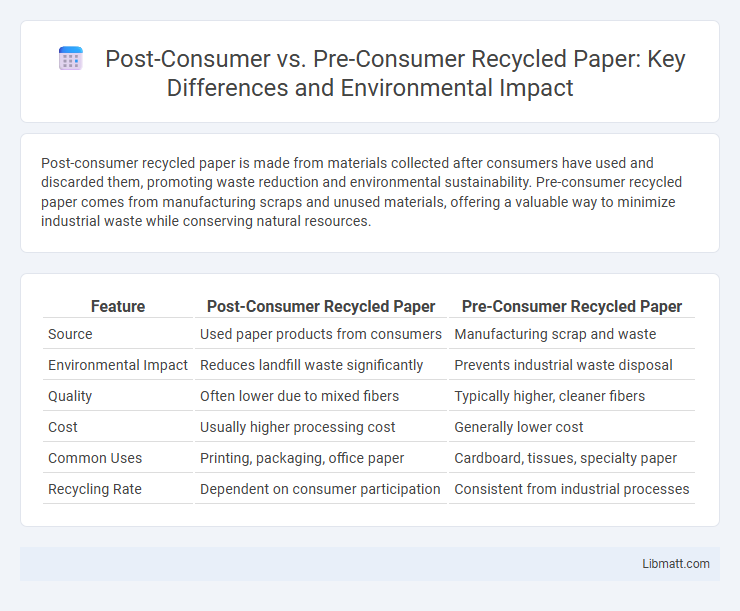Post-consumer recycled paper is made from materials collected after consumers have used and discarded them, promoting waste reduction and environmental sustainability. Pre-consumer recycled paper comes from manufacturing scraps and unused materials, offering a valuable way to minimize industrial waste while conserving natural resources.
Table of Comparison
| Feature | Post-Consumer Recycled Paper | Pre-Consumer Recycled Paper |
|---|---|---|
| Source | Used paper products from consumers | Manufacturing scrap and waste |
| Environmental Impact | Reduces landfill waste significantly | Prevents industrial waste disposal |
| Quality | Often lower due to mixed fibers | Typically higher, cleaner fibers |
| Cost | Usually higher processing cost | Generally lower cost |
| Common Uses | Printing, packaging, office paper | Cardboard, tissues, specialty paper |
| Recycling Rate | Dependent on consumer participation | Consistent from industrial processes |
Understanding Post-Consumer vs Pre-Consumer Recycled Paper
Post-consumer recycled paper is made from materials discarded by consumers after use, such as used office paper or packaging, ensuring waste reduction from the consumer side. Pre-consumer recycled paper consists of manufacturing scraps and trimmings collected before reaching consumers, often from production processes like paper mills. Choosing post-consumer recycled paper supports circular waste management and reduces landfill impact more effectively than pre-consumer sources.
What Is Post-Consumer Recycled Paper?
Post-consumer recycled paper is produced from materials collected after consumers have used and discarded them, such as office paper, magazines, and newspapers. This type of recycled paper reduces landfill waste and conserves natural resources by reprocessing paper that has completed its initial lifecycle. Using post-consumer recycled fibers supports sustainable production and minimizes environmental impact compared to virgin paper.
What Is Pre-Consumer Recycled Paper?
Pre-consumer recycled paper is made from manufacturing waste and scraps that are collected and reprocessed before reaching consumers, typically including trimmings and rejected materials from paper mills or printing operations. This type of recycled paper reduces industrial waste by diverting unusable paper remnants from landfills, promoting sustainable production practices. Your choice of pre-consumer recycled paper supports circular resource management by minimizing raw material consumption and energy use within the paper manufacturing industry.
Key Differences Between Post-Consumer and Pre-Consumer Paper
Post-consumer recycled paper is made from materials discarded by consumers after use, such as old newspapers and office paper, whereas pre-consumer recycled paper originates from manufacturing scraps and trimmings not used by consumers. Post-consumer recycled content contributes directly to reducing landfill waste and supports a closed-loop recycling system, while pre-consumer recycled content mainly reduces industrial waste during production. The environmental impact of post-consumer recycled paper is generally higher due to its role in diverting consumer waste, making it a preferred choice for sustainable paper products.
Environmental Benefits of Post-Consumer Recycled Paper
Post-consumer recycled paper significantly reduces landfill waste and lowers greenhouse gas emissions by diverting used paper from disposal and reprocessing it into new products. It conserves natural resources such as trees, water, and energy, making it a more sustainable choice compared to pre-consumer recycled paper, which primarily uses manufacturing scraps. Utilizing post-consumer recycled content supports circular economy initiatives and promotes responsible consumption patterns.
Sustainability Impact of Pre-Consumer Recycled Paper
Pre-consumer recycled paper reduces environmental impact by diverting manufacturing waste from landfills and minimizing the demand for virgin pulp, conserving natural resources such as trees and water. This type of recycling typically involves scraps and offcuts generated during paper production, making it an efficient way to reuse materials without affecting the quality of the final product. Utilizing pre-consumer recycled paper lowers energy consumption and greenhouse gas emissions compared to producing paper solely from virgin fibers, contributing to more sustainable paper manufacturing processes.
How Recycled Paper Is Collected and Processed
Post-consumer recycled paper is collected from used products discarded by consumers, such as office paper and newspapers, and then sorted, cleaned, and de-inked to remove contaminants before being reprocessed into new paper. Pre-consumer recycled paper involves scraps and waste generated during the manufacturing process, which are re-collected directly from factories, pulped, and reintegrated into production without entering the consumer market. Both recycling streams reduce waste and lower demand for virgin fiber, but post-consumer recycling requires more intensive sorting and cleaning to ensure quality and remove inks, adhesives, and other residues.
Choosing the Right Recycled Paper for Your Needs
Post-consumer recycled paper is made from materials discarded by consumers after use, providing a stronger environmental impact by reducing landfill waste. Pre-consumer recycled paper, produced from manufacturing scraps and trimmings, offers consistent quality and fewer contaminants, ideal for high-grade print needs. Understanding your specific project requirements helps you select the recycled paper that balances sustainability with performance effectively.
Industry Standards and Certification Labels
Post-consumer recycled paper is sourced from materials discarded by end-users and aligns with industry standards like FSC Recycled and Green Seal, ensuring environmental responsibility. Pre-consumer recycled paper comes from manufacturing scraps that never reached consumers, often certified under standards such as SCS Recycled Content Label. Your choice between these types can be guided by certification labels that verify the percentage of recycled content and adherence to sustainability criteria.
Future Trends in Recycled Paper Production
Post-consumer recycled paper, sourced from used consumer products, is increasingly favored for its environmental benefits and contribution to reducing landfill waste, while pre-consumer recycled paper, derived from manufacturing scraps, remains essential for minimizing industrial resource consumption. Future trends in recycled paper production emphasize advanced sorting technologies and chemical recycling methods to enhance fiber quality and expand usability in various applications. Your choice between these types will likely influence sustainability impacts as the industry moves toward circular economy practices and carbon footprint reduction.
Post-consumer vs pre-consumer recycled paper Infographic

 libmatt.com
libmatt.com